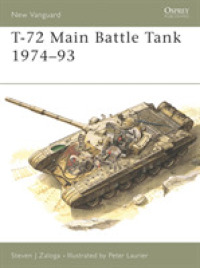- ホーム
- > 洋書
- > 英文書
- > Science / Mathematics
Full Description
Computational Methods and Experimental Measurements XIX
In its 19th year the International Conference on Computational Methods and Experimental Measurements continues to provide highest quality research which forms this book. This volume examines a wide variety of topics related to new experimental and computational methods.
The continuous improvement in computer efficiency, coupled with diminishing costs and the rapid development of numerical procedures have generated an ever-increasing expansion of computational simulations that permeate all fields of science and technology. As these procedures continue to grow in magnitude and complexity, it is essential to validate their results to be certain of their reliability. This can be achieved by performing dedicated and accurate experiments, which have undergone a constant and enormous development. At the same time, current experimental techniques have become more complex and sophisticated so that they require the intensive use of computers, both for running experiments as well as acquiring and processing the resulting data.
Some of the subject areas covered are: Computational and experimental methods; Fluid flow; Structural and stress analysis; Electromagnetic problems; Structural integrity; Destructive and non-destructive testing; Heat transfer and thermal processes; Advances in computational methods; Automotive and Aerospace applications; Applications in industry; Ocean engineering and marine structures; Fluid structure interaction; Bio-electromagnetics; Hybrid methods; Process simulations; Validation of computer modelling; Virtual testing and verification; Simulation and forecasting; Measurements in engineering.
Earthquake Resistant Engineering Structures XII
Major earthquakes and associated effects continue to stress the need to carry out more research and a better understanding of these phenomena in order to design earthquake resistant buildings and to carry out risk assessments. This volume combines the latest leading research as presented on the 12th edition of the ERES conference.
As the world's population has concentrated in urban areas resulting in buildings in regions of high seismic vulnerability, we have seen the consequences of natural disasters take an ever higher toll on human existence. Protecting the built environment in earthquake-prone regions involves not only the optimal design and construction of new facilities, but also the upgrading and rehabilitation of existing structures including heritage buildings. The type of highly specialized retrofitting employed to protect the built heritage is an important area of research.
The research papers included in this volume cover: Seismic isolation and energy dissipation; Building performance during earthquakes; Numerical analysis; Performance based design; Experimental studies; Seismic hazards and tsunamis; Safety engineering; Liquefaction; Innovative technologies; Paraseismic devices and Lifelines and resilience.
Contents
Contents
Part I - Computational Methods and Experimental Measurements XIX
Preface
Behaviour of small fatigue cracks in Cu-5.5Ni-1.28Si alloy round-bar specimens; Numerical modeling of high-velocity, projectile penetrating concrete blocks reinforced by Teflon sheets; Crowd-flow simulation using the potential pathline method; CFD analysis of low frequency oscillations in Newtonian and non-Newtonian fluids in a vertical pipe; Molten state of thermoplastic resin in an injection moulding barrel; Devices for environmental observations; Uncertainty of measurement in HPM pulse testing; Robust double active control system design for disturbance rejection; Analysis of Japanese folding fan's characteristic structure and traditional technical skill; Study on vessel motion control with towing ropes and dampers for berthing; Digital emulation of dielectric relaxation functions for capacitive sensors of non-destructive dielectric spectrometry; Correct sizing of reflectors in ultrasonic inspection of the forging titanium alloy; Automatic detection of loitering behaviour using spatiotemporal image processing; Fundamental study of an adaptive evacuation guide sign by using a discrete element method-based simulation; Effect of carbon nanotube grafting onto carbon fibre on the conductivity of carbon fibre-reinforced thermoplastic laminates
Special session: Computer modelling applications for civil engineering
(Organised by Y. Villacampa)
3D modelling of dune ecosystems using photogrammetry from Remotely Piloted Air Systems surveys; Compressive strength classification of lightweight aggregate concrete using a support vector machine model; Modified soil tests for scour analysis on offshore windfarm foundations; Non-linear numerical models for predicting the bond strength of fibre-reinforced concrete at high temperatures; Optimisation of models for the determination of the crest of bars on sandy beaches
Author index
Part II - Earthquake Resistant Engineering Structures XII
Preface
Numerical model of TRM-reinforced masonry walls under lateral in-plane loads; Lateral behaviour of steel frames with precast reinforced concrete exterior infill panels; Behavior of precast reinforced concrete beam-column external connections under cyclic loading; Vulnerability assessment of modular steel platform structures under seismic loads; Vulnerability assessment of buildings based on rapid visual screening and pushover: Case study of Gyor, Hungary; Predicting the peak seismic response of a retrofitted nine-storey steel reinforced concrete building with steel damper columns; Earthquake resistance of reinforced concrete shells of diverse forms in the plane and with different contours; Seismic performance comparison between structure-improvement techniques and ground-improvement techniques: Application to a reinforced concrete school building; Feasibility of the underground earthquake bracelet
Tsunami shoaling theory
Author index




